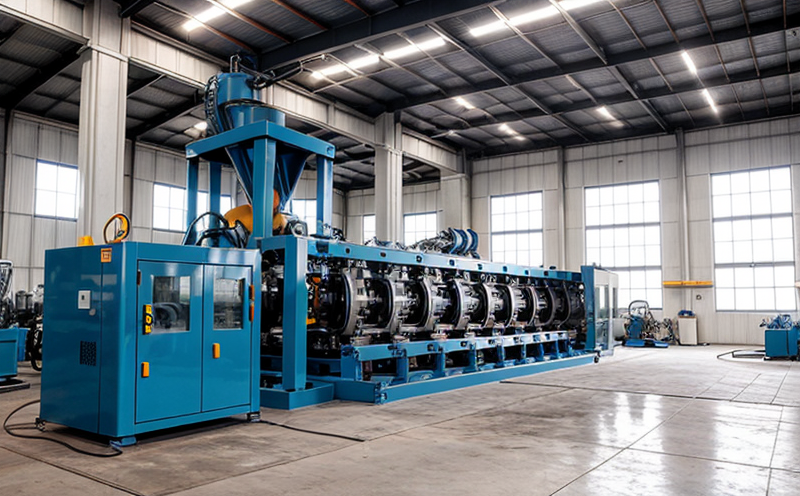ISO 12482 Crane Condition Monitoring Testing
The ISO 12482 standard is a critical pillar in the industrial manufacturing and processing sector, ensuring that cranes are maintained to peak performance levels. This standard focuses on condition monitoring practices for cranes used in various industries such as construction, logistics, and manufacturing. Compliance with this standard not only ensures operational safety but also extends the lifespan of crane components, reducing maintenance costs and downtime.
Condition monitoring involves continuous or periodic checks to identify any signs of wear, damage, or degradation that could lead to failures in critical machinery like cranes. The process typically includes visual inspections, non-destructive testing (NDT), vibration analysis, lubrication condition assessment, and more. This service helps industrial facilities maintain their equipment efficiently by providing actionable insights into the health of each crane.
The ISO 12482 standard specifies a framework for cranes used in industrial applications to undergo periodic inspections and tests to ensure they meet safety requirements. By adhering to this protocol, companies can reduce risks associated with mechanical failures that could cause accidents or production disruptions. The standard covers a wide range of crane types including overhead travelling cranes, gantry cranes, and mobile cranes.
One key aspect of ISO 12482 is its emphasis on the use of advanced technologies such as IoT sensors for real-time data collection and analysis. This technology allows operators to monitor critical parameters like temperature, stress levels, and operational efficiency from remote locations. Such continuous monitoring ensures that any anomalies are detected early, enabling proactive maintenance rather than reactive repairs.
Another significant advantage of this service is the ability to integrate condition monitoring with predictive maintenance strategies. Predictive maintenance uses historical data and current trends to forecast potential issues before they become critical. This approach helps in optimizing resource allocation by scheduling maintenance activities during off-peak hours, thereby minimizing disruptions to production schedules.
Industrial facilities that adopt ISO 12482-compliant condition monitoring practices experience numerous benefits. These include improved safety standards within the workplace, enhanced reliability of cranes, extended equipment lifecycle, reduced costs associated with unplanned downtime and repairs, and increased overall productivity due to minimized maintenance interruptions.
For quality managers and compliance officers, implementing ISO 12482 ensures that all aspects of crane operation are continuously evaluated against industry best practices. This not only enhances the reputation of the company but also demonstrates a commitment to safety and excellence in manufacturing processes.
R&D engineers can leverage this service by integrating condition monitoring systems into new designs, ensuring they meet or exceed regulatory requirements from the outset. Procurement teams benefit from knowing that suppliers adhere to these stringent standards, leading to more reliable and durable cranes being delivered on time.
Applied Standards
| Standard Reference | Description |
|---|---|
| ISO 12482-1 | Condition Monitoring for Cranes: General Principles and Requirements |
| ISO 12482-2 | Condition Monitoring for Cranes: Application to Overhead Travelling Cranes |
| ISO 12482-3 | Condition Monitoring for Cranes: Application to Gantry Cranes |
Customer Impact and Satisfaction
The implementation of ISO 12482 in crane condition monitoring leads to significant improvements in customer satisfaction. By ensuring that cranes operate within specified parameters, industrial facilities can maintain safe working environments while minimizing the risk of accidents or failures. This directly impacts customer trust and confidence in the reliability of services provided.
Customers benefit from reduced operational costs due to fewer breakdowns and extended equipment life cycles. Predictive maintenance strategies supported by condition monitoring allow for more efficient scheduling of maintenance activities, which can lead to increased availability and uptime of cranes during peak production periods.
The service also enhances the overall quality of products manufactured or processed using these cranes. With consistent performance levels guaranteed through regular checks and adjustments, there is less variability in output consistency, leading to higher product quality standards across industries relying on heavy lifting equipment like cranes.
Furthermore, compliance with ISO 12482 demonstrates a commitment to best practices within the sector, which can be a key differentiator for industrial companies seeking to meet or exceed expectations set by their clients. This aligns well with corporate social responsibility initiatives aimed at promoting sustainable business practices and responsible resource use.
For procurement teams involved in selecting suppliers for cranes or related services, adherence to this standard provides assurance that the chosen supplier meets rigorous quality control measures. Such assurances can translate into long-term partnerships based on mutual respect and shared goals towards excellence in manufacturing processes.
Use Cases and Application Examples
| Use Case/Application Example | Description |
|---|---|
| Construction Site Crane Operations | In a busy construction site, cranes are used extensively for moving materials and equipment. Regular condition monitoring ensures that these machines operate safely without compromising on performance. |
| Logistics Warehouses | Warehouses often use overhead cranes to move heavy pallets efficiently within large storage facilities. Continuous monitoring helps maintain the integrity of these systems, ensuring reliable operations even under high loads. |
| Mining Operations | In mining environments where safety is paramount due to hazardous conditions, condition monitoring plays a crucial role in preventing failures that could lead to severe accidents involving large pieces of equipment. |





